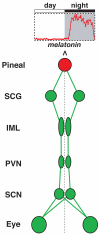Circadian regulation of pineal gland rhythmicity
- PMID: 21782887
- PMCID: PMC3202635
- DOI: 10.1016/j.mce.2011.07.009
Circadian regulation of pineal gland rhythmicity
Abstract
The pineal gland is a neuroendocrine organ of the brain. Its main task is to synthesize and secrete melatonin, a nocturnal hormone with diverse physiological functions. This review will focus on the central and pineal mechanisms in generation of mammalian pineal rhythmicity including melatonin production. In particular, this review covers the following topics: (1) local control of serotonin and melatonin rhythms; (2) neurotransmitters involved in central control of melatonin; (3) plasticity of the neural circuit controlling melatonin production; (4) role of clock genes in melatonin formation; (5) phase control of pineal rhythmicity; (6) impact of light at night on pineal rhythms; and (7) physiological function of the pineal rhythmicity.
Copyright © 2011 Elsevier Ireland Ltd. All rights reserved.
Figures




References
-
- Aguiar LM, Macedo DS, de Freitas RM, de Albuquerque Oliveira A, Vasconcelos SM, de Sousa FC, de Barros Viana GS. Protective effects of N-acetylserotonin against 6-hydroxydopamine-induced neurotoxicity. Life Sci. 2005;76:2193–2202. - PubMed
-
- Arendt J. Melatonin and the Mammalan Pineal Gland. Chapman & Hill; London: 2005.
-
- Arendt J, Broadway J. Light and melatonin as zeitgebers in man. Chronobiol Int. 1987;4:273–282. - PubMed
-
- Attanasio A, Rager K, Gupta D. Ontogeny of circadian rhythmicity for melatonin, serotonin, and N-acetylserotonin in humans. J Pineal Res. 1986;3:251–256. - PubMed
-
- Bach AG, Muhlbauer E, Peschke E. Adrenoceptor expression and diurnal rhythms of melatonin and its precursors in the pineal gland of type 2 diabetic goto-kakizaki rats. Endocrinology. 2010;151:2483–2493. - PubMed
Publication types
MeSH terms
Substances
Grants and funding
LinkOut - more resources
Full Text Sources

